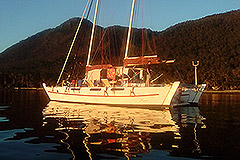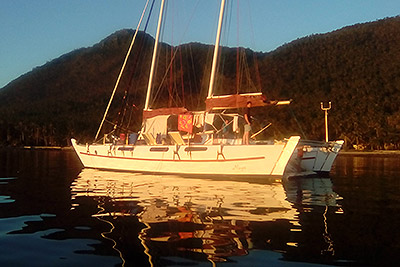Sailing Cruise Philippines #1
|
Image courtesy: John Smart
|
A sailing cruise aboard S/Y Naya
Fancy a sailing cruise in the Philippines? We will have to be friends first . . . in return you will enjoy some of the prettiest sailing cruise destinations in the Philippines and chance to meet some of the ocean’s most astounding creatures.
We set sail from Laiya, Batangas, with the intent of starting our five day sailing cruise by crossing to the island of Marinduque; to be specific, to the Tres Reyes island chain, off the southwest of Marinduque Island. However, the wind did not favor this plan and so, fairly early, we changed course for the volcano island of Sibale (also known as Conception and Maestre de Campo, depending on the map you use).
I love Sibale, and I have done so, ever since I first arrived there, aboard the daily ferry from Pinamalayan, on the East coast of Oriental Mindoro. This time, for the first time, I would arrive aboard the sailing yacht Naya.
Sailing Cruise Destination: Sibale
Sibale was once a fierce volcano, throwing boulders, large and small, and vast quantities of ash towards the heavens as it slowly grew out of the sea. Today, Sibale has no evident volcanism, which is fortunate for the 4,000 or so inhabitants of the island (because there would be nowhere to run), but the island’s past can be viewed in dramatic relief around most of the shoreline – where erosion has exposed the layers of volcanic debris previously exploded skyward before gravity took control.
At anchor off the town of Conception, we were greeted by the acting head of the Sibale tour guide association: the ever modest and distinctly charming Annabelle. She arranged the following morning activities for our friends aboard. We settled down for a good night sleep at what proved to be a very peaceful anchorage.
A visit in the morning to the turtle nesting beach delivered just one of the island’s most unusual inhabitants: the tabon bird. Looking a little like a black guinea fowl, the tabon bird does not like to fly too much, so it does not nest in trees. Instead the bird digs a hole in the sand and lays its eggs there, about half a meter or so down, then covers the eggs and scurries away into the bushes. How the hatchlings dig themselves up and out of the sand remains a mystery but, as there are so many tabon birds in the vicinity, dig themselves up and out they must.
The tabon bird is just one of the many unusual, natural surprises to be found on Sibale but it would take another few days, that we did not have, to thoroughly explore the island’s fauna and flora.
By mid-morning, we set sail again, headed East, for either Banton or Simara island – wherever the breeze would allow. By mid-afternoon, the breeze gave up and we motored to Banton Island – the then closer of the two. Banton Island is not mentioned in any guidebook that we had aboard.
Sailing Cruise Destination: Banton Island
Banton Island, like Sibale, is the direct result of volcanism, displaying evidence of such around every headland. Where it differs from Sibale is that here on Banton there was much molten lava, laid down in the latter part of its creation.
Based on the crew’s local knowledge, we anchored in Mainit Bay, on the West coast of the Banton Island. Annabelle had made contact ahead of time and waiting to greet us was Nikki, from the mayor’s office.
From Nikki, we learned that Banton is home to a large community of indigenous people, who can trace their roots back into the distant past. Because the population is still relatively small, there is still some original rainforest on the island, which is home to native lizards, snakes, monkeys and other creatures that only have local names, and whose description places them beyond my easy classification without direct observation.
According to the information provided, none of the snakes on Banton Island are poisonous although there are a number of pythons that have grown to large proportion. As described, there are monitor lizards and sail-fin dragons, mostly observed as they scurry across the narrow roadways at the sound of approaching humans. We were advised that turtles may be seen around the whole island but that they are only known to nest on beaches on the North coast.
Here in Mainit Bay we saw turtles surfacing near the yacht during the late afternoon and again in the early morning. I suspect that the turtles enjoy Mainit Bay because of the hot springs that were observed beneath many parts of the bay, sending columns of warm, mineral-rich water to the surface.
We took Nikki’s advice and, the following morning, visited the marine sanctuary around the point that was effectively the northern extreme of Mainit Bay. Anchoring here is forbidden so we left one person in charge of the drifting yacht and leapt into the crystal clear waters.
The corals here are quite exquisite, especially the hard corals. Marine life is not as bountiful as in some places but what was lacking in volume, was made up for in diversity and novelty. All the colors of the rainbow in fact – starfish of so many hues, green clown fish and bright red damsels – too many more to list here.
I have decided that I shall have to return to Banton Island with my partner, and spend a week or more exploring. And then the guidebook will definitely have an entry for the unique island of Banton.
Sailing Cruise Destination: Romblon
Sibale and Banton are just two islands within the province of Romblon. Now, our sailing cruise is taking us to the island after which the province is named: Romblon Island.
Romblon Island is known as the “marble capitol” of the Philippines. True to its name, even from a distance, you can see the marble quarries almost as clearly as you can see the remainder of the island.
We found a mooring off Anchor Bay Watersports, just to the South of the town of Romblon, close to the enigmatic Bonbon Island. Enigmatic because you can walk to the island at low tide, across a sandbar, which in theory means the island is not an island at all; with an approaching high tide, walking to Bonbon Island is impossible because the tidal flow across the sandbar is too strong. That night, at low tide, we barbecued on the sandbar, just for the novelty, and to celebrate a birthday.
After sunrise we voyaged into the port of Romblon and our party went ashore to purchase the essential Romblon marble souvenirs – so inexpensive here compared to anywhere else on the planet. The other delights and sights of Romblon (Spanish era forts & churches, rivers, corals, shipwrecks and more) will have to wait another visit because we have planes to catch in Caticlan two days from now.
We head out from Romblon, under sail, on the last long-leg of our sailing cruise, this time to the southern tip of Tablas Island – the largest island in Romblon province and sometimes called the market garden of Romblon.
Sailing Cruise Destination: Tablas
From previous visits I can attest to the fact that possibly the very best gelato in the whole of Asia can be enjoyed on Tablas Island. By shear coincidence, two Italian family businesses have made Tablas their home and make simply, the most delicious gelato ice cream and sorbet from locally grown fruits. My personal favorite is calamansi sorbet.
Gelato was not on our menu this day however, because our voyage was to take us to the southeast corner of Tablas.
A voyage along the East coast of Tablas Island highlights the “market garden” theme of the island. Small holdings and large holdings of cultivation on the lower slopes, and almost every ridge lined with coconut palms. Occasional small fires were evident from their smoke, sadly indicating yet another piece of forest being converted to agriculture.
As the sun started to ease towards the West, we found ourselves close to Tugdan airport (Romblon province’s only operating airport). We witnessed a shoal of young marlin feeding ferociously in a circle of death – if you were their prey; and, half a dozen separate shoals of skip-jack tuna, leaping with determination for their supper.
Rounding the last hump that marks the end of Tablas Island we found our recommended anchorage at sunset. We dropped the anchor into a circle of clear water, surrounded on three sides by rocky outcrops and sandbars. We retired early with anticipation of the final day of sailing to our ultimate objective: Boracay.
As the sky darkened to night and the heavens came alive with a trillion stars, we picked out the constellations we knew, and easily found the true North that has guided sailors since the dawn of ocean navigation. Near the opposite horizon was the Southern Cross, that Captain Cook et al would have used to keep themselves focused on the opportunity of discovering new lands to occupy beyond their encounter with Neptune.
At the southwest horizon, red lights flashed to the left of a gentle glow. From past adventures we knew the glow to be the beaches of Boracay but the red lights were new. The red lights, we concluded, sat atop the highest of the 18 or more wind turbines that now speckle the hillsides of northern Panay Island, generating power for the ever expanding commerce that supports the international, tropical beach destination of Boracay.
We finally slept.
As the rising sun paled the eastern horizon, fishermen were returning home with the fruits of their night’s labor. We waved down one of the boats and purchased some still-alive fish for lunch, much to the delight of the fishermen who would now not need to compete for a buyer ashore.
Sailing Cruise Destination: Boracay
Sails hoisted, we said goodbye to Tablas and the beauty of Romblon province, and steered a course southwest to the port of Caticlan; our destination was to be the anchorage off Station 3, at the South end of Boracay’s stunning white beach.
To reach Caticlan, and eventually Boracay, we passed the larger Carabao Island. About five miles to the East of Carabao we had the chance to see up to 100 dolphins herding their prey into a tight circle from where they would pick and choose their breakfast. Stupidly, a couple on a jetski from Boracay ran through the pod of dolphins and scattered them. Repeatedly the jetski driver swooped into the pod, presumably to delight his companion; obviously not to study nor enjoy the vista of so many animals.
Eventually the pod headed away, leaving us with a sense of awe at the spectacle of so many dolphins leaping and spinning above the water. Also leaving us with a sense of frustration concerning the extreme arrogance or ignorance (or both) of the jetski driver, and a wish that he would run out of fuel far from any hope of rescue.
The breeze eased to almost nothing, our approach to Caticlan was slow. Our spinnaker was barely full as we ghosted past the rocky islands that mark the eastern approach to Caticlan port. However, the rate of progress gave time to observe the incredible scale of recent development on Boracay Island and to contemplate the relative benefits of tourism in an area where there has been little or no residential, commercial or town planning, for a period of almost forty years.
I would wish that I had taken a few photographs, instead of memories, of the Boracay Island I first visited in 1982. At least then people would understand why I cannot compliment myself for promoting this island, nor the many other places I fell in love with during my travels through this most beautiful country during the 1980s and ever since. My regret is that I did not buy every square inch of the island when it was affordable, and keep it just the way it was, when it was the subject of a whispered question amongst serenity-seekers in Hong Kong: “psst! . . . have you been to Boracay yet?”
We motored the last portion to Boracay Station 3, through the gaggle of boats going to and from somewhere, packed full of people seeking something they had heard of, but could no longer find beyond their collection of Facebook selfies. We struggled to find a vacant spot to drop the anchor. Happily, perhaps, the only spot available was directly opposite one of the few bar/pubs that has not changed for a decade or more (and I hope it never will): Red Pirates – 500 meters walk South from Station 3. Motor boats whizzed past us creating unnecessary wake, sailing paraws passed within inches of our hull with dazed passengers not sure why they were spending so much money to go such short distances through a boat park.
No carpet of stars were visible that night, for the lights of Boracay Beach push high into the firmament and obscure all but the brightest planets. A cacophony of electronic sounds pulsated across the water towards us.
We retired early with the expectation of rising at 3am, when to disgorge ourselves from five days of beautiful sailing cruising in the Philippines, to return by early plane to Metropolis Manila. But we had done what we set out to do: take our new friends on a voyage of 150+ miles through the heart of the Philippines, to places they had never been, to experience things they had only previously imagined and to witness a few things that only the lucky few will ever see in their lifetimes.
A sailing cruise through the Philippines can be a life changing event. Do it now; make new friends and discover things you never knew you never knew about this World.
Sailing Cruise References
charter a yacht in the Philippines



 idyllic anchorage at Banton Island
idyllic anchorage at Banton Island